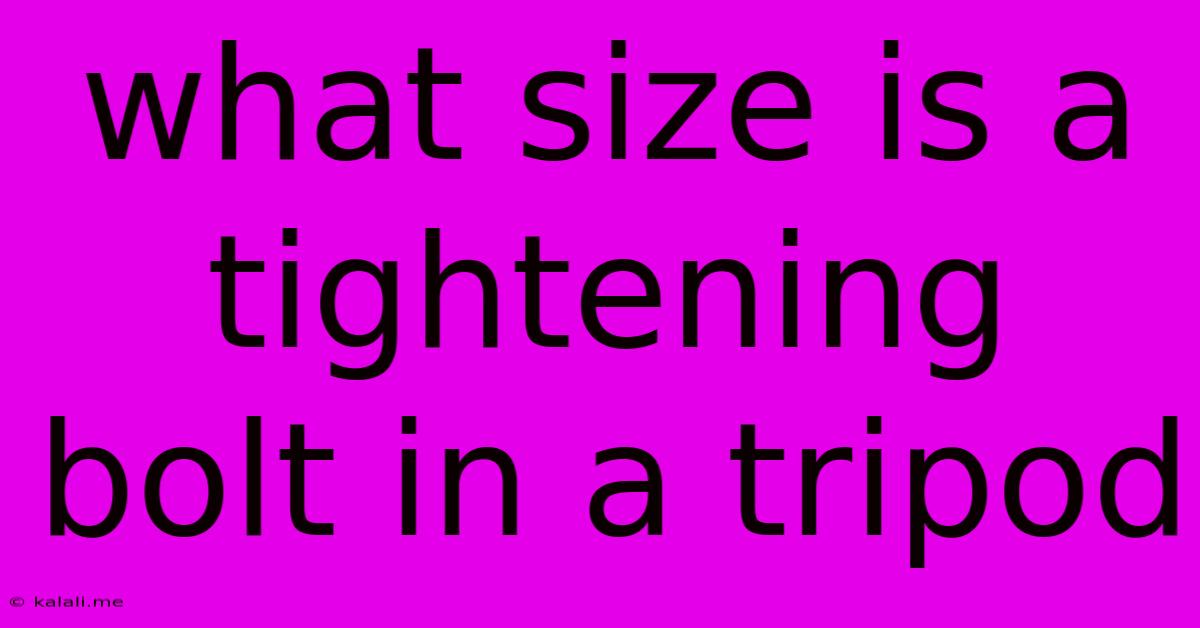What Size Is A Tightening Bolt In A Tripod
Kalali
Jun 07, 2025 · 3 min read

Table of Contents
What Size is a Tightening Bolt in a Tripod? A Comprehensive Guide
Finding the right size tightening bolt for your tripod can be surprisingly tricky. This seemingly small component plays a crucial role in the stability and safety of your equipment, so getting it right is essential. This guide will delve into the variations, common sizes, and troubleshooting tips to help you find the perfect fit.
Why is Knowing the Bolt Size Important?
Knowing the size of your tripod's tightening bolt is vital for several reasons:
- Stability: A properly tightened bolt ensures your tripod is secure and stable, preventing accidental collapses and equipment damage. Loose bolts can lead to vibrations affecting your images or videos, especially at longer focal lengths.
- Safety: A secure bolt prevents your expensive camera equipment from falling and getting damaged or, worse, causing injury.
- Repairs: If a bolt is stripped or broken, knowing the size allows you to easily replace it and get your tripod back in working order.
The Variability of Tripod Bolt Sizes:
Unfortunately, there's no single standard size for tripod tightening bolts. The size depends heavily on the tripod's manufacturer, model, and even the specific leg section. Common sizes include:
- 1/4"-20: This is a relatively common size, often found in smaller, lighter tripods. The "1/4" refers to the diameter of the bolt, and "20" refers to the number of threads per inch.
- 3/8"-16: Larger, heavier-duty tripods frequently use this size. It offers increased strength and stability.
- Metric sizes: Some tripods, particularly those from manufacturers outside the US, may use metric threads such as M6, M8, or even larger.
How to Identify Your Tripod's Bolt Size:
If you don't have the original documentation, there are a few ways to determine the size:
- Visual Inspection: Carefully examine the bolt. The size might be engraved on the bolt head itself (although this isn't always the case).
- Use a Thread Gauge: A thread gauge is a tool with various sized threads that you can use to match the threads on your bolt. Hardware stores and online retailers carry these.
- Take the Bolt to a Hardware Store: Bring the bolt with you to a hardware store. An experienced associate should be able to easily identify the size.
- Check the Manufacturer's Website: If you know the make and model of your tripod, the manufacturer's website or support documentation might contain specifications including bolt sizes.
Troubleshooting Common Issues:
- Stripped Threads: If the threads on your bolt are stripped, you'll likely need to replace the entire bolt. Replacing it with the correct size will restore the tripod's functionality.
- Lost or Damaged Bolt: If you've lost or damaged the bolt, take it to a hardware store and get a replacement bolt of the same size and material. Ensure it's a high-quality bolt designed to withstand stress.
Maintaining Your Tripod:
Regular maintenance is crucial for ensuring the longevity of your tripod and the stability of your gear. Periodically inspect your tripod's bolts and legs to check for any signs of damage or loosening. Tighten all the bolts regularly to maintain stability.
Conclusion:
While there isn't a universal bolt size for all tripods, understanding the common sizes and methods to identify your specific tripod's bolt size will ensure its stability and safety. Remember, a properly tightened bolt is essential for the protection of your equipment and the quality of your work. Always prioritize safety and proper maintenance to ensure your tripod remains a reliable tool for years to come.
Latest Posts
Latest Posts
-
How To Make The Bottom Sharepoint Bar Bigger
Jun 07, 2025
-
How To Get Rid Of Red Outline On Roblox
Jun 07, 2025
-
Export Glb From Blender With Texture
Jun 07, 2025
-
Like In Sql For Multiple Values
Jun 07, 2025
-
Aero Bars On A Mountain Bike
Jun 07, 2025
Related Post
Thank you for visiting our website which covers about What Size Is A Tightening Bolt In A Tripod . We hope the information provided has been useful to you. Feel free to contact us if you have any questions or need further assistance. See you next time and don't miss to bookmark.